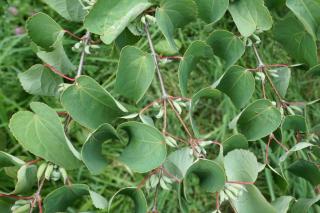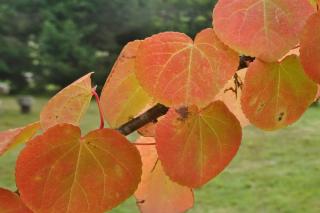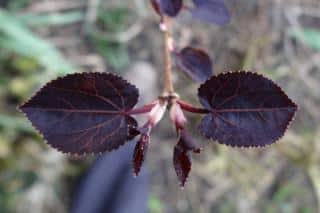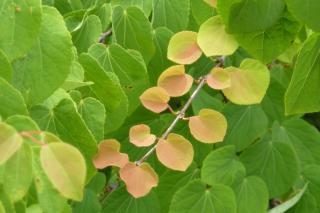

Visitors often overlook the caramel tree because its blooming is discrete and fragrance-less. The tree’s silhouette isn’t particularly remarkable, but there is one thing that will make you remember it for ever: the smell of its leaves!
A true blast from the past with its cotton-candy smell, this smallish but graceful tree releases this caramel-like taste when leaves begin to turn red in fall.
Key Caramel tree facts
Name – Cercidiphyllum japonicum
Family – Cercidiphyllaceae
Type – tree
Height – 25 to 36 feet (8 to 12 m)
Exposure – intense full sun, to veiled light
Sol – cool, very acidic to neutral
Foliage – deciduous
Flowering – in April
The caramel tree is ideally planted in fall, but can also be planted in spring if it is purchased in a container. Apart from fall and spring, avoid days where there is either strong heat, or below freezing temperatures. It is hardy down to -4°F (-20°C).
 It loves full sun exposure if the climate in your area is cool. However, if summer gets very hot, it’s better to shelter it with shade trees because it would suffer a lot in dry weather.
It loves full sun exposure if the climate in your area is cool. However, if summer gets very hot, it’s better to shelter it with shade trees because it would suffer a lot in dry weather.The caramel tree thrives best in rich soil. If the soil in your garden isn’t very rich, you can amend it and make it better.
Maintenance is reduced, especially when the tree is well settled in.
 This tree naturally takes on a very harmonious shape, and pruning it is often unnecessary.
This tree naturally takes on a very harmonious shape, and pruning it is often unnecessary.
This deciduous tree will usually only reach 25 to 35 feet (8 to 12m) in our temperate climates, but in its native habitat, it easily reaches gigantic proportions: over 120 feet (40 m) tall, with a girth of nearly 15 feet across (4.5 meters). The botanical name, “Cercidiphyllum” is a reference to the heart-shaped leaves, which are similar to those of the Judas tree. The name for the Judas tree is Cercis in latin, phyllum being the word to designate “leaf”.
What makes this tree famous, though, is related to its common name: “apple toffee tree” or “caramel tree” – even the name “cotton candy tree” has appeared. Indeed, the most surprising aspect of this tree are the heady sweet scents that wafts out from its gold-colored leaves in fall. They’re nearly exactly the same smells as those of caramel or gingerbread! The intensity of the smell waxes and wanes, becoming particularly pungent when fog and mist arise.
The tree often naturally forms many trunks side-by-side. From these, horizontal branches stem outwards and tend to droop to the ground.
The flowering is insignificant. It appears in April, even before any leaves appear. Trees are either male or female, so you won’t have both types of flowers on the same tree. Fruits are kind of like pea pods, about 1 to 2 inches long (1.5 to 5 cm).
 Another appealing aspect of this tree is the color of its foliage which starts out bright red in spring then turns green, before switching to yellow, pinkish orange and violet in October. There are actually a few cultivars that have deep purple leaves such as Cercidiphyllum japonicum ‘Rotfuchs’ (show here, with guttation drops around the edge of the leaves), others with weeping habits like the C. japonicum ‘Pendulum’, and still others with variegated foliage, of which the 12-15 foot tall ‘Chameleon’ is a good example (4-5m).
Another appealing aspect of this tree is the color of its foliage which starts out bright red in spring then turns green, before switching to yellow, pinkish orange and violet in October. There are actually a few cultivars that have deep purple leaves such as Cercidiphyllum japonicum ‘Rotfuchs’ (show here, with guttation drops around the edge of the leaves), others with weeping habits like the C. japonicum ‘Pendulum’, and still others with variegated foliage, of which the 12-15 foot tall ‘Chameleon’ is a good example (4-5m).
 Many who have this tree share that it seems happiest whenever a taller tree covers it in shade during the hotter periods of the day. Pair it with a Magnolia, a Liquidambar or a Liriodendron, since these three trees have the same needs. In coastal climates, however, it does well even when planted as a standalone.
Many who have this tree share that it seems happiest whenever a taller tree covers it in shade during the hotter periods of the day. Pair it with a Magnolia, a Liquidambar or a Liriodendron, since these three trees have the same needs. In coastal climates, however, it does well even when planted as a standalone.
To complete your landscaping around this tree, try planting Cornus kousa and florida and even a few Japanese maple trees nearby: it’ll be a competition as to which one has the most marvelous fire-colored leaves in fall!
Purchase your saplings rather on the tall side, from 2 to 5 feet tall (60 to 150 cm): the tend to settle in much easier than smaller ones.